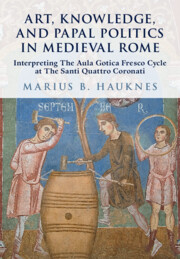 Art, Knowledge, and Papal Politics in Medieval Rome
Art, Knowledge, and Papal Politics in Medieval Rome Book contents
- Art, Knowledge, and Papal Politics in Medieval Rome
- Art, Knowledge, and Papal Politics in Medieval Rome
- Copyright page
- Dedication
- Contents
- Acknowledgments
- Introduction
- One The Santi Quattro Coronati Frescoes in Context
- Two Art, Learning, and Reflective Viewing
- Three Emblems of Time and Political Power
- Four Allegory, History, and Political Eschatology
- Five Visual and Material Entanglement in the Anagni Crypt
- Six Conclusion
- Appendix Inscriptions Appearing in the Aula Gotica Frescoes
- Bibliography
- Index
- References
Bibliography
Published online by Cambridge University Press: 30 January 2025
- Art, Knowledge, and Papal Politics in Medieval Rome
- Art, Knowledge, and Papal Politics in Medieval Rome
- Copyright page
- Dedication
- Contents
- Acknowledgments
- Introduction
- One The Santi Quattro Coronati Frescoes in Context
- Two Art, Learning, and Reflective Viewing
- Three Emblems of Time and Political Power
- Four Allegory, History, and Political Eschatology
- Five Visual and Material Entanglement in the Anagni Crypt
- Six Conclusion
- Appendix Inscriptions Appearing in the Aula Gotica Frescoes
- Bibliography
- Index
- References
- Type
- Chapter
- Information
- Art, Knowledge, and Papal Politics in Medieval RomeInterpreting the Aula Gotica Fresco Cycle at Santi Quattro Coronati, pp. 311 - 348Publisher: Cambridge University PressPrint publication year: 2025
